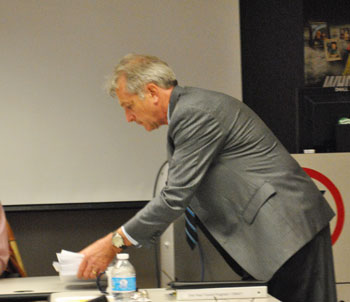5-Year Transit Plan: Possible Tax Vote Soon
Ann Arbor Area Transportation Authority board meeting (Jan. 16, 2014): The board’s one substantive voting item on its agenda was the adoption of a five-year transit improvement plan. The unanimous vote came after a staff presentation and public commentary from three people, who all expressed support for the improvement program.

Yellow lines indicate routes along which the AAATA is planning frequency improvements as part of its five-year transit improvement plan. (Image links to .pdf of full presentation given to the board on Jan. 16, 2014)
Generally, the improvements include increased frequency during peak hours, extended service in the evenings, and additional service on weekends. Some looped routes are being replaced with out-and-back type route configurations. The plan does not include operation of rail-based services. The AAATA has calculated that the improvements in service add up to 90,000 additional service hours per year, compared to the current service levels, which is a 44% increase.
The AAATA refers to the plan in its communications as the 5YTIP. A draft five-year plan was presented to the public in a series of 13 meetings in the fall of 2013. Changes to the five-year plan made in response to public feedback were included in the board’s information packet for the Jan. 16 meeting. [.pdf of memo and 5-year improvement plan] [.pdf of presentation made to the board on Jan. 16]
The plan indicates that $5,456,191 of additional local revenue would be required to fund the expanded services. Implementation of the program will include a request to voters sometime in 2014 for an additional transit millage, likely at the level of 0.7 mills.
The two city members of the AAATA – Ann Arbor and Ypsilanti – already levy a dedicated transit millage of their own, which would stay in place if voters in the AAATA’s three-jurisdiction area approved a 0.7 mill tax. For Ann Arbor, the rate for the existing millage is 2.056 mills, which is expected to generate a little over $10 million by 2019, the fifth year of the transportation improvement plan. For the city of Ypsilanti, the rate for the existing transit millage is 0.9789, which is expected to generate about $314,000 in 2019. For the owner of an Ann Arbor house with market value of $200,000 and taxable value of $100,000, a 0.7 mill tax translates into $70 annually, which would be paid in addition to the existing transit millage that translates to about $200 annually.
The transit improvement program also calls for an additional $1,087,344 to come from purchase of service agreements (POSAs), based on increased service hours in Pittsfield, Saline, and Superior townships.
At the Jan. 16 meeting, board chair Charles Griffith indicated that he felt the board would be taking the next step on implementing the program very soon. That indicates a probable vote on the millage question at the next board meeting, on Feb. 20. If the board voted then to put a millage question on the ballot, that would be in time to meet the Feb. 25 deadline for a millage request to be placed on the May 6, 2014 ballot.
A new millage would be decided by a majority vote of all three member jurisdictions of the AAATA. The two Ypsilanti jurisdictions were added as members of the AAATA just last year. The Ann Arbor city council voted to approve changes to the AAATA’s articles of incorporation – to admit the city and the township of Ypsilanti as members – at its June 3, 2013 and Nov. 18, 2013 meetings, respectively.
Even though the vote on the five-year transit improvement program seemed to be enthusiastically embraced by most everyone in the board room, that was not what prompted people to start clapping at the Jan. 16 meeting. The applause was reserved for the management and driver performance during the recent snowstorm. Board member Jack Bernard and likely future board appointee Larry Krieg both based their praise for drivers on their own trips using the bus. Praise for AAATA drivers during the inclement weather also came from bus rider Jim Mogensen during public commentary. And CEO Michael Ford highlighted the performance of AAATA’s manager of transportation Ron Copeland, as well as that of drivers and the rest of the AAATA staff.
The board also received routine updates on a range of issues. Those included ridership, which is now essentially flat on the fixed-route service compared to last year. The new Blake Transit Center in downtown Ann Arbor is expected to be open for use by the second week in February. Concepts for two finalists for the BTC public art project – which will be incorporated into the new building – will be on display at the downtown location of the Ann Arbor District Library from Jan. 20 through Feb. 3. The downtown library is located across the street from the BTC. [Full Story]




